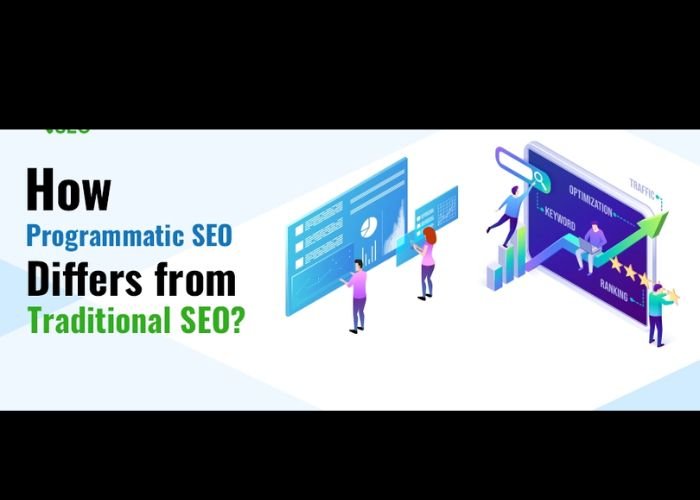Site design improvement (Website optimization) is a foundation for organizations hoping to build their web-based perceivability in the consistently developing computerized showcasing scene. Over time, methods for optimizing websites have undergone a lot of change, leading to new and more effective approaches.
Both traditional SEO and programmatic SEO are well-known methods that have gained popularity. This article expects to dive into the nuances of these two strategies, unraveling their variations and understanding how they shape the mechanized publicizing scene.
Understanding Traditional SEO:
Upgrading a site to support its natural inquiry rankings is known as conventional Search engine optimization, and it has for some time been the underpinning of computerized showcasing. Watchword enhancement, content creation, third-party referencing, and on-page enhancement are just a few of the deeply rooted works on this approach.
The primary objective is to adapt the website to the calculations made by web crawlers, making it more relevant and legitimate to web indexes like Google.
How Does Programmatic SEO Differ From Traditional SEO?
The Essence of Traditional SEO:
- Keyword-Centric Optimization: Enhancing catchphrases is a major piece of conventional website streamlining. The content of businesses’ websites incorporates strategically relevant keywords related to their goods or services. This empowers web crawlers to understand the importance and setting of the site’s contributions.
- Quality Content Creation: Quality composing is everything in the area of standard Web architecture upgrade. High-quality, informative, and engaging content not only meets the needs of the audience, but it also piques the interest of search engines. Regularly reviving and adding new cheerful is an indispensable piece of traditional Site streamlining.
- Link Building: Link building is an important part of traditional SEO. A website’s credibility is demonstrated to web indexes by having excellent backlinks from reputable sites. This procedure includes outreach, building relationships, and creating shareable content.
- On-Page Optimization: Ensuring that solitary pages are improved for web search devices is huge in regular Web streamlining. This includes simplifying headers, meta labels, and other on-page elements to make the site more visible in search engine results.
Programmatic SEO: A Paradigm Shift
Programmatic SEO, as opposed to traditional SEO’s manual and somewhat linear approach, places automation and data-driven decision-making front and center. Automatic web optimization gradually improves a website’s display through the use of AI calculations and man-made consciousness (computer-based intelligence). This strategy focuses primarily on making adjustments in real time based on user behavior, market trends, and other dynamic factors.
Programmatic SEO: A Paradigm Shift
- Automation and AI Integration: The indication of Programmed Site enhancement is its reliance on computerization and mimicked knowledge. To pursue constant choices and dynamic systems, AI calculations examine enormous amounts of data. Because of this, businesses are able to quickly respond to shifting customer behavior and pursuit examples.
- Dynamic Content Optimization: Unlike traditional Web composition upgrade, which regularly incorporates infrequent substance invigorates, Programmed Web enhancement considers dynamic substance smoothing out. AI algorithms can tailor content based on user preferences and interactions in real time, making each visitor’s experience unique.
- Predictive Analytics: Computer-based intelligence calculations can make informed expectations by dissecting verifiable information. This enables businesses to remain vigilant and proactively modify their Website optimization strategies.
- Cross-Channel Integration: Programmatic SEO reaches further than traditional search engines. It includes email, portable applications, virtual entertainment, and other computerized channels.
- Enhanced User Experience: Programmed Site streamlining puts serious solid areas for an on conveying a better client experience. Optimizing the website’s content and structure in accordance with AI algorithms’ analysis of user behavior and preferences can result in higher levels of user engagement and satisfaction.
Choosing the Right Approach:
The choice between Programmed Site advancement and Standard Web streamlining depends upon various components, including the possibility of the business, the vested party, and the serious scene. The ideal methodology frequently includes a crossover model that combines elements of the two strategies, each of which has advantages and disadvantages.
- Business Goals and Objectives: Think about the organization’s general goals. If long-term stability and establishing a strong organic presence are the primary objectives, traditional SEO might be the best choice.
- Budget and Resource Allocation: Traditional website optimization frequently necessitates a significant expenditure of resources and time, particularly in the initial stages. Despite the fact that it might require a bigger beginning interest in innovation and devices, automatic Website optimization can possibly smooth out continuous techniques and lessen difficult work over the long run.
- Competitive Landscape: Study the reality of the business and the level of submersion in web crawler results. A top notch customary Website optimization procedure might yield huge outcomes in less packed markets.
- Target Audience and User Behavior: It’s important to know the ideal interest group and how they act online. If the audience is known for rapidly shifting preferences and actions, the real-time adjustments made by Programmatic SEO may better meet the audience’s expectations.
- Long-Term vs. Short-Term Goals: Traditional search engine optimization is frequently associated with long-term manageability, gradually building authority and perception over time. Programmatic SEO may be better suited to short-term goals and quick market responses due to its dynamic and adaptable nature.
Conclusion:
To stay cutthroat and applicable, organizations should explore the intricacy of Search engine optimization systems as the computerized scene keeps on evolving. Traditional SEO and programmatic SEO are two distinct approaches that each have their own advantages and disadvantages. To settle on an educated choice or take on a cross breed technique. That consolidates the benefits of the two procedures, it is fundamental to grasp the particular necessities of the organization. Its interest group, and the scene of contest.

